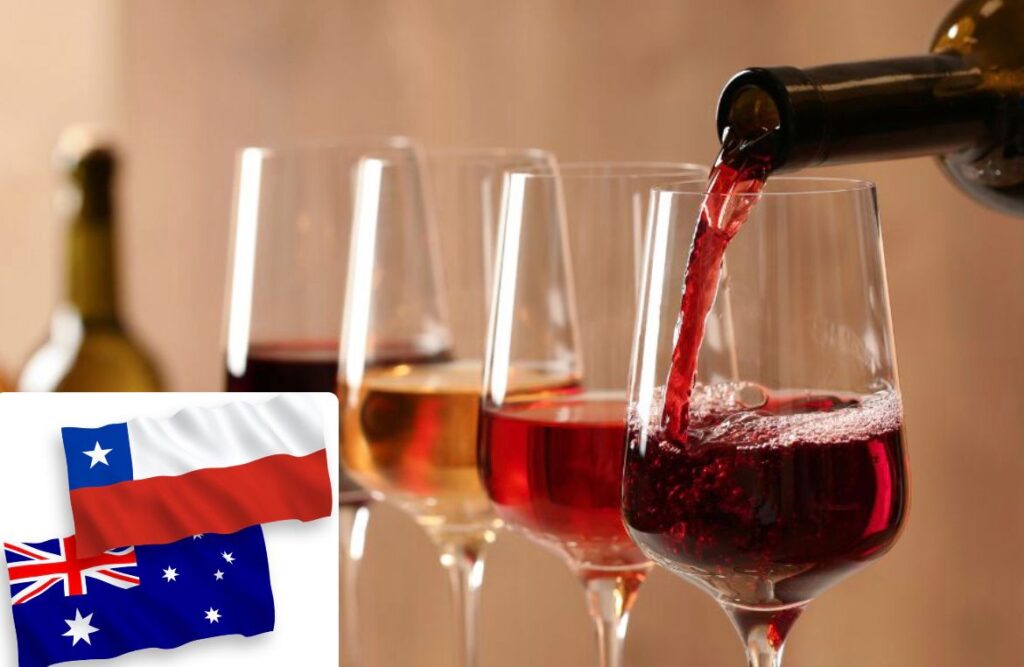As European wine retailers navigate rising inflation, tighter margins, and shifting consumer preferences, two major Southern Hemisphere producers—Australia and Chile—are increasingly vying for dominance on the same battleground: European retail shelves. Once operating in largely distinct markets, these countries are now colliding in key segments and territories, offering similar products to the same buyers.

The Rise of Overlapping Export Strategies
Both Australia and Chile have built reputations as reliable sources of high-quality, value-for-money wines. Their portfolios are broad, their exports heavily supported by national marketing bodies, and both have matured into consistent players in the €6–€12 price bracket that dominates European supermarket sales. Traditionally, Australia has maintained a strong foothold in the UK and Ireland, while Chile’s exports have flourished in Germany, the Netherlands, and Scandinavian countries. But in 2025, the dividing lines are fading. Export data shows Chile’s wine shipments to Europe grew 6.1% year-on-year in the second quarter, with notable gains in Northern and Western European markets. At the same time, Australia recorded a 4.8% rebound in its UK and Irish exports, reversing a years-long downward trend post-Brexit and amid changing trade conditions.
Similar Wines, Same Shelf
This overlap is no longer theoretical. Buyers at leading retail chains across Europe report increasingly being pitched near-identical varietals—Sauvignon Blanc from Chile’s Casablanca Valley versus Australia’s Adelaide Hills, Cabernet Sauvignon from Maipo Valley competing with Coonawarra, and Chardonnay from Limarí going up against Margaret River. The wines are similarly styled, similarly priced, and equally well supported by promotional programs. In other words, they’re now fighting for the same shelf slots.
Brand Recognition and Consumer Perception
In terms of brand recognition, Australia retains an advantage in the UK, where names like Yellow Tail and Jacob’s Creek still hold sway among mainstream consumers. However, Chile is making inroads with a newer wave of organic and sustainably positioned wines. Brands like Emiliana and Cono Sur are carving out space in the hearts of eco-conscious shoppers, particularly among millennials and Gen Z.
The Sustainability Factor
The sustainability narrative is playing a larger role in European purchasing decisions, and Chile currently leads in certified sustainable vineyard acreage. That said, Australia is moving quickly to catch up, with its “Sustainable Winegrowing Australia” initiative gaining ground in both domestic operations and global messaging.
Trade Policy and Logistics
Logistics and geopolitics are also shaping the playing field. Chile benefits from an established free trade agreement with the European Union, giving its exporters a modest pricing advantage. Australia, while still negotiating final terms of a post-Brexit trade deal with the EU, has shown positive momentum in 2025, particularly through enhanced cooperation with individual markets like the Netherlands and Ireland.
Retailer Realities and Strategic Choices
From the perspective of European retailers, both countries are becoming increasingly interchangeable, especially at entry and mid-tier price points. Decisions on which wines to list often come down to strategic factors like differentiation, storytelling, and promotional support. A buyer at a mid-sized German supermarket chain recently commented that Chilean whites feel fresher and more vibrant to their consumers, while Australian reds offer more structure and body—traits that resonate well with meat-focused meal occasions.
A Shrinking Shelf and Rising Stakes
The bigger picture is clear: shelf space is limited, and the competition is intensifying. As more private-label programs and local European wines reclaim space post-COVID, both Australia and Chile must work harder to justify their presence. Simply offering good wine at a fair price is no longer enough. Success will depend on targeted branding, consistent quality, flexible logistics, and the ability to help retailers tell a story that connects with their specific market.
Conclusion: A Battle That’s Only Just Begun
Whether this is a long-term collision or a case of parallel coexistence remains to be seen. But one thing is certain—Europe is no longer big enough for both countries to grow without friction. The question is: who will adapt faster?